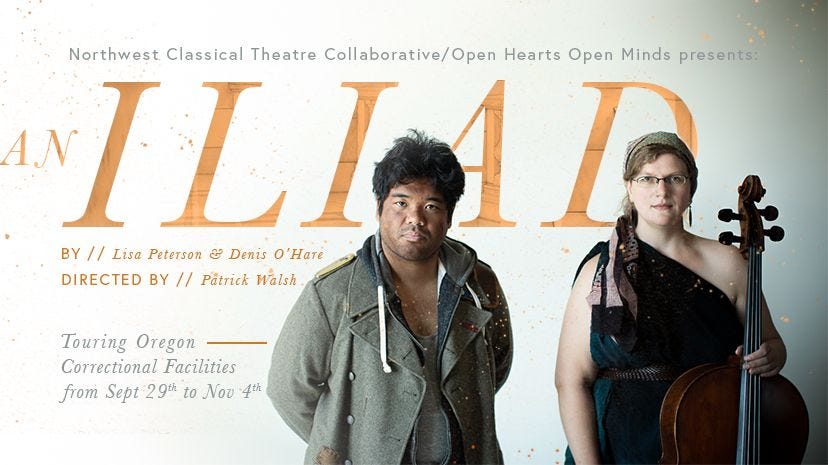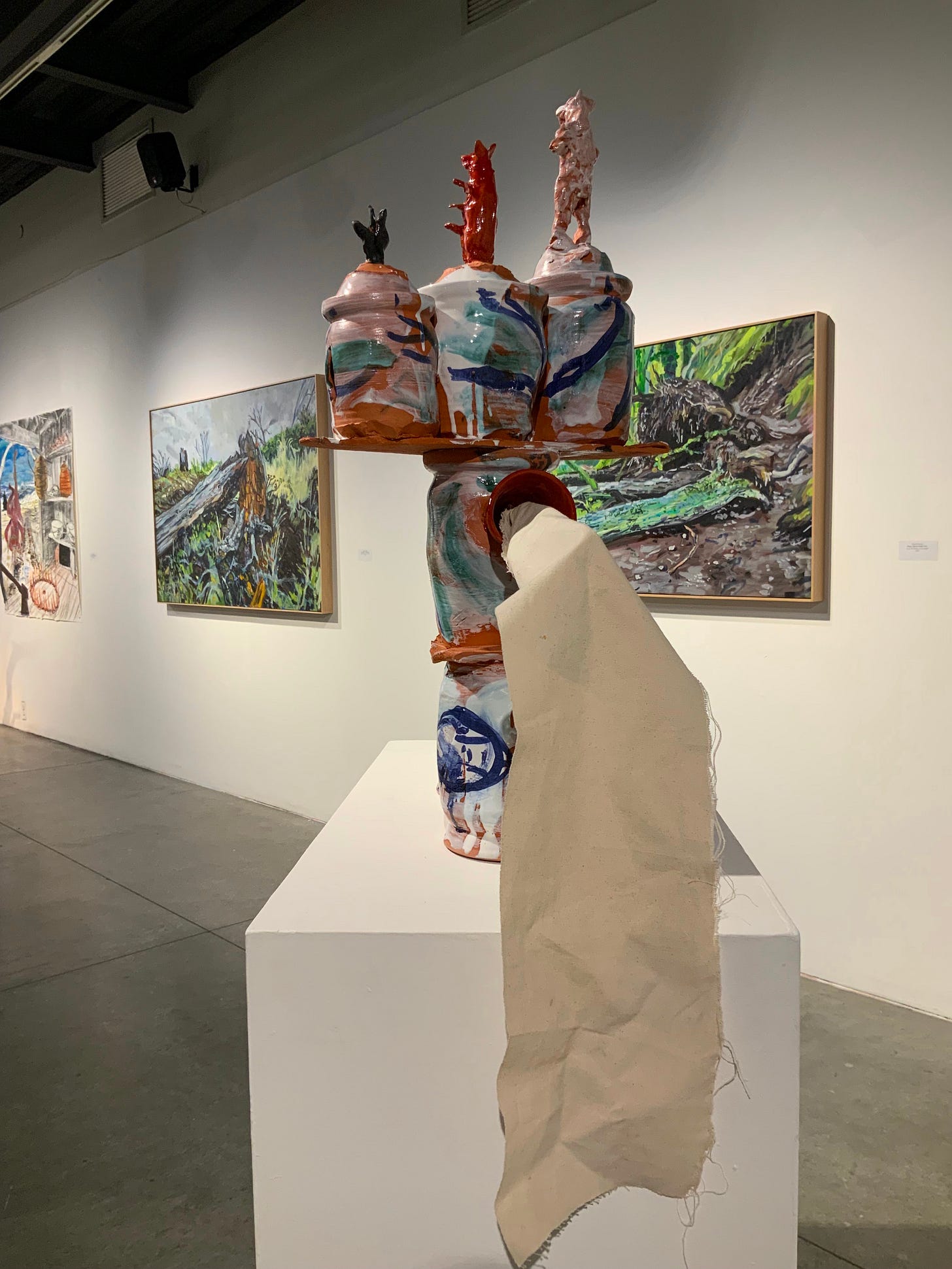AN ILIAD
This week’s story is “The White Snake” from the Grimm Brothers collection. Before we get into the story I want to tell you about a performance I saw onThursday night at Portland Center Stage at theArmory. An Iliad was part of the micro festival Risk/Reward The Election Anti-Party. The Fig Tree Committee has been performing the play in prisons, schools and other community spaces. I got to know them because my wife Tracy Schlapp through her non-profit Bridgeworks brought them into Coffee Creek and Oregon State Penitentiary. (You should go read Pony Xpress, Bridgework’s beautiful weekly Substack of writings from prison around the state) The play was written by Lisa J. Peterson and Denis O’Hare. This production is performed by Paul Susi as the Poet and Anna Fritz as The Muses (who also composed the score). An Iliad strips the epic poem down to its distilled raw core.
Since they usually perform in auditoriums, community rooms and carceral spaces they rely on a few props: Paul Susi’s WWI military coat, a chair and Ann Fritz’s cello. Fritz employs subtle facial expressions in response to Susi so that even if she is the muse, she is no silent witness to the poet’s performance. The black box Ellyn Bye Studio had the full house lights on with no curtains or other adornments. It was naked, vulnerable performance. Everything is up to Susi’s vocal delivery and posture and Fritz’s melancholy score and gestures.
The Iliad is a hard piece to love. Compared to The Odyssey which has many in-roads to the human experience, The Iliad is blood-soaked and rage-filled. And yet it compels; it speaks to us. Right now, as terrible wars wage in Gaza and Sudan and the United States is only a couple of years out of a twenty year war in Afghanistan, The Iliad is evergreen.
Earlier this summer I read a book called Hearing Homer’s Song by Robert Kanigel about the early twentieth century anthropologist Millman Parry. Parry upended Homeric studies when he realized that Homer, if it was a single person, may have been illiterate or at the very least newly literate. The epithets throughout Homer’s epics such as “the black ships” of the Greeks don’t necessarily describe their color. They are oral handholds for itinerant poets who performed for hours or days. We may read The Iliad and The Odyssey, but we are meant to hear them. An Iliad is a scripted performance with a composed score, and yet it felt like what listening to a great improvisational, storyteller. Susi is a magnetic performer. His coat begins as the ragged cloak of an exhausted and reluctant poet. It then transform on the floor to a body of a fellow soldier. It becomes armor and the body of Hector. The chair is a place to sit as imperious Agamemnon and then knocked over it becomes Patroclus in death. With just a few vocal cues and gestures he transforms into a frightened and defiant Andromache or noble Hector undone by war fury. Fritz is no mere backdrop. As the Poet beseeches the Muses for assistance in the telling of the story, she sits turned away shunning his entreaties.
One of the curious aspects of The Iliad is the chapter in which each ship is listed. We walk away from the action to do this martial accounting. In An Iliad the Poet describes how many young men and boys are on all the ships and then compares them to young men drained out of small American towns to go off to war. It becomes personal as the poet begins to describe the boys he knew and how old they were when they were killed. This isn’t about abstract glory. It puts us right into the deadly metrics of massive wars. There is a list which becomes the crescendo of the piece. The Poet begins to compare it to another war and then an unstoppable gravitational force pulls on the list as it unspools from ancient Greece through history and around the globe until today. It ends with Gaza. That is a fist of stone once it lands on you. As the Poet is caught in this whirlpool of horror, the Muses play a discordant lament, Fritz simultaneously tapping on the hollow body of the instrument. In the Greek epics, men weep openly. Lamentations are both public and private affairs. Lamentation is essential to the catharsis and alchemy of grief. Even with Emily Wilson’s excellent new translation, it is easy to create a scholarly emotional distance between yourself and the story. With Susie and Fritz’s performance, one must weep. You weep because the rage of young men and seemingly divine winds enflaming power-hungry wars very much exist today.
An Iliad is performed in prisons and spaces like McClaren Youth Correctional Facility. These spaces are filled with young men who have fallen because of fits of unstoppable rage. Unfortunately, the current reactive climate lumps this all under the accusatory “toxic masculinity”. They are painted mostly as monsters. Achilles is undone by his rage. An Iliad reminds us that we too are all susceptible to killing rages. The piece allows each participant to feel the rage, the regret, the grief of all the characters. You can be both Achilles and Patroclus, or Hector and Andromache. You become the grieving father Priam, willing to give up everything for the body of his slain son. This empathy through story allows us all to wear the masks of monster and hero, victor and victim.
In this telling, we are reminded not only that The Iliad is present in our world with so much still to tell us, but that it is decidedly not pro-war propaganda. Through Susi’s channeling of individual characters we are very aware of the loss not only of young men’s lives but the destruction of cities, communities, the assault and rape of women and the lack of any clear winner in a war. Through this telling, Susi and Fritz delivered a deeply human performance that threads the narrative string from ancient Greece to the present day.
THE WHITE SNAKE
I suggest you listen to the story before reading this.
“The White Snake” was a lesser known story to me. A few years ago when I began my Masking Pictures in Troubled Times workshops I wanted stories that featured a very clear animate world. I first used “The White Snake” in “The Earth Talks Back” workshop. It featured stories with divinatory ravens, sentient trees and other signs of the animate land. “The White Snake” spoke to me immediately. It goes right to the heart of enchantment. I don’t mean the kind of enchantment you see in Disney movies. I’m speaking of the kind of enchantment Sharon Blackie writes about in The Art of Enchantment. This enchantment describes being awake to the multitudinous voices of the living world.
In this story like many fairy tales, there is a sovereign who is holding vital knowledge for himself. The white snake is a resource he uses for his own gain. It is possible to also consider that he is a shaman-king involved in a sacred ritual. In that case it might not be hoarding something as much as protecting and honoring it. As usual, there is no essential, correct answer. It all depends on when this story encounters you. Where you are in your life changes your relationship to stories.
The young man/servant breaks this priestly sanctity. Again, he could be a thief defiling something sacred or a trickster who must steal a resource locked up by a king to release energy back into the world. Either way, his theft gives him incredible insight. He can now hear the voices of the more than human world. One clue about the king’s true nature is that he has no problem joining with the queen in banishing the young man on no evidence. They both behave as expected of the entitled. It is no wonder the young man wants nothing to do with them and refuses to be bought off.
His journeys follow a similar pattern in European folktales. He is the empathetic traveler. Many times you see this play out as the youngest sibling who must follow two older siblings who behave like brats (in the old sense of the word, not as in Charli XCX). The older siblings get their comeuppance and watch as the humble younger sibling performs all the tasks through kindness. In this case, the young man can hear the voices of all the animals, fish and insects. Their pleas and entreaties are crystal clear. Imagine that, if we all had a small bite of the white snake right now. How differently would we conduct ourselves in the world and together? The young man seeks no payment or favor as he helps those he encounters. It is the precise reason he is given aid later.
The princess doesn’t seem like such a catch. She is overly class conscious and a bit of a pill. She goes back on her work mid contest and changes up the rules. She is someone who has the capacity for empathy but has grown swaddled in wealth and power and so can’t feel the spirits of others. The Golden Apple finally opens up her heart. In all of these stories it never helps to judge too much. If you openly identify only with the hero or protagonist you miss something essential. There are times in our lives when we are the curious and wily servant whose small transgression opens up the possibility of our lives, but there are also times when you’re a clueless king, an uniformed princess, a lost adolescent raven or the queen of the ants. I imagine that the power of the white snake might need to be encountered only once to change your life, but it will take work to remember that bit of grace. If like the king, who seemed to be micro-dosing the snake, you’ll never truly understand the gift. It would be easy to equate the white snake and the golden apple to mind-altering drugs. But remember–neither of those things could be monetized or tamed. The young man doesn’t devour the whole snake, he discreetly takes one small bite. The apple can only be gotten once with the help of animal envoys who you would have had to aid with no expectation of reciprocation.
Enchantment takes work. You have to attempt it everyday even when the dulling daily distraction sucks you into its fog. But then you get an opportunity: you hold the white snake in a secret corridor with only a minute to spare, or someone brought you half a golden apple even though you were a bit of a jerk to them. When you get to taste those delicacies, don’t waste it. A whole world wants you to hear its song.
AND A REMINDER:
On Tuesday October 1st is an opening reception for American Underland at The Archer Gallery at Clark College in Vancouver, WA
Exhibition Dates: September 16 - December 20th, 2024
Opening Reception: October 1st, 3 -6pm, Archer Gallery
Artist Talk: October 15th, 1 - 2pm, PUB 161
Saturday Reception: November 2nd, 1 - 4pm, Archer Gallery.
Virtual Artist Workshop: Thursday, November 7th, 1:30. - 3:30pm, https://clark-edu.zoom.us/j/89432337559
info@archergallery.space
(360) 992-2246
1933 Fort Vancouver Way
Vancouver, WA 98663
Gallery viewing hours: Mon-Sat, 11am-5pm












Share this post